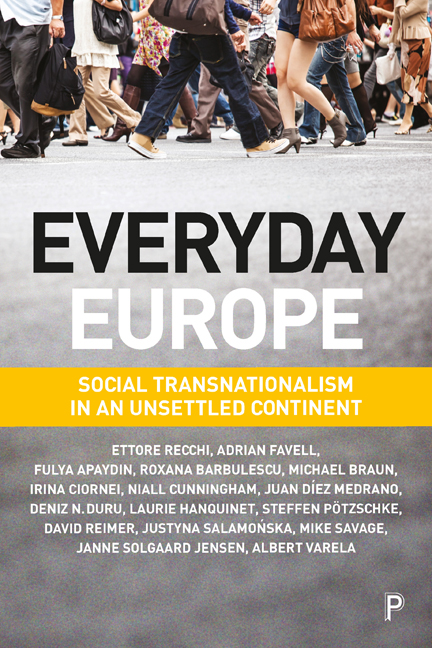Book contents
- Frontmatter
- Contents
- List of tables and figures
- Notes on contributors
- Acknowledgements
- Introduction: Social transnationalism in an unsettled continent
- one Cartographies of social transnationalism
- two The social structure of transnational practices
- three Cultural boundaries and transnational consumption patterns
- four Social transnationalism and supranational identifications
- five Explaining supranational solidarity
- six Narratives and varieties of everyday transnationalism
- seven Understanding Romanians’ cross-border mobility in Europe: movers, stayers and returnees
- eight Transnational Turkey: the everyday transnationalism and diversity of Turkish populations in Europe
- Epilogue Is social transnationalism fusing European societies into one?
- Methodological appendix
- Index
four - Social transnationalism and supranational identifications
Published online by Cambridge University Press: 19 April 2022
- Frontmatter
- Contents
- List of tables and figures
- Notes on contributors
- Acknowledgements
- Introduction: Social transnationalism in an unsettled continent
- one Cartographies of social transnationalism
- two The social structure of transnational practices
- three Cultural boundaries and transnational consumption patterns
- four Social transnationalism and supranational identifications
- five Explaining supranational solidarity
- six Narratives and varieties of everyday transnationalism
- seven Understanding Romanians’ cross-border mobility in Europe: movers, stayers and returnees
- eight Transnational Turkey: the everyday transnationalism and diversity of Turkish populations in Europe
- Epilogue Is social transnationalism fusing European societies into one?
- Methodological appendix
- Index
Summary
Introduction
The analysis of national and supranational identification of native populations offers an important research agenda. This is not the least since the concerns and interests of citizens, or their lack of interest in certain topics and concepts, are legitimate factors in the decision making of democracies. In this sense, questions of identification are relevant for the positioning of countries towards each other and, in particular, for their cooperation in the framework of supranational entities, such as the European Union, or even on a global scale. Contrary to opinions often expressed by different national actors in public debates, most studies have come to the conclusion that there is no incompatibility between national and European identifications but rather that they are complementary (Díez Medrano and Gutiérrez 2001; Citrin and Sides 2004; Duchesne and Frognier 2002; 2008; Bruter 2005).
As hypothesised in Deutsch's transactionalist theory (Deutsch et al 1957), transnational relations of national populations, such as frequent foreign travel, knowledge of foreign languages and foreign friends, have been demonstrated to increase identification with larger regional entities (Kuhn 2011; 2015). However, transnational interactions are highly stratified across society and the younger and more highly educated are much more frequently involved in these interactions than the elderly and the less educated. As a consequence, the level of identification with Europe does not necessarily rise in tandem with an increase in these interactions. Instead, stratification with regard to interactions could be reflected by stratification with regard to identification.
Using quantitative data gathered in 2012 and 2013 as part of the EUCROSS study, this chapter examines the identification at various different scales (city, region, country, Europe and the world) of nationals of Denmark, Germany, Italy, Romania, Spain and the United Kingdom, as well as Romanian and Turkish migrants to these countries. However, the focus is on identification with Europe and the difference between identification with Europe and the world as a whole. By doing so we are investigating the conscious self-identification of individuals. It is not our aim to go beyond this and speculate on the existence of a ‘European identity’. In drawing this distinction we follow Brubaker and Cooper (2000), who argue that ‘identity’, due to its nature as a social construct, is not suitable as an analytical category.
- Type
- Chapter
- Information
- Everyday EuropeSocial Transnationalism in an Unsettled Continent, pp. 115 - 136Publisher: Bristol University PressPrint publication year: 2019

